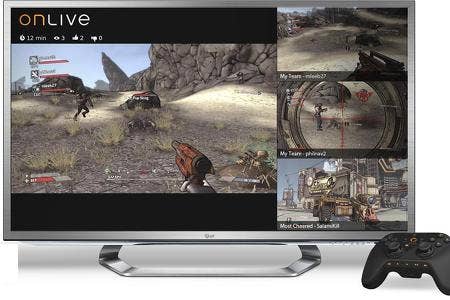True cross-platform play coming from the cloud
OnLive and Razer's cloud-based services promise the same high-end PC experience wherever you play
At an E3 2012 cloud gaming presentation featuring OnLive and Razer, the International Data Corporation (IDC) focused on cloud gaming bringing a real cross-platform experience to players everyhere. While major platform holders have been reluctant to support cloud gaming outside of save syncs, OnLive and Razer believe more can be done to improve the service for consumers. The first step involves teaching consumers what cloud gaming actually entails, as a survey by the IDC shows that only 48 percent of consumers know what the term really means.
While Sony is playing with cross-platform gaming via PlayStation 3/PlayStation Vita connections and CCP is adding the FPS Dust 514 to the EVE Online universe, cloud gaming is the full promise of cross-platform play. OnLive CEO Steve Perlman explained that nearly any device that could stream online video has the ability to play premium PC titles. Users gain the ability play these titles in cross-platform play without shelling out more cash for proprietary hardware, meaning a user's dollar could go directly to software.
Centralized cloud gaming negates game piracy - with an 89 percent piracy rate for mobile games cited in the presentation - and gives developers the ability to patch titles quicker. Used games also become a non-issue with the service. Without piracy, the revenue for software titles is shared strictly between publishers and OnLive, with publishers getting 50 percent or more of the share. OnLive hopes to bring its services to small developers and free-to-play titles in the future.
OnLive cited 2 to 2.5 million cloud games played on a big-screen, according to a Q1 survey, and 100 percent uptime with more than 250 titles from more than 60 developers. It also mentioned its partnerships with hardware vendors including Vizio, HTC, and LG.
Perlman took the time to show off OnLive MultiView spectating mode, allowing players to keep track of three other play streams at once.
Perlman also showed off tablet-specific touch controls, with the example at the conference being a specially-designed version of L.A. Noire runing on an Android tablet. The full game was present - despite being a multiple disc title on Xbox 360 - and Rockstar has added touch overlays to the game for tablet control. Unfortunately, while the OnLive client is available on iOS and Android, the approval for the iPad version of the app hasn't come through. Perlman mentioned that OnLive iPad was submitted almost a year ago.
Razer, on the other hand, showed off its Synapse 2.0 suite, allowing Razer owners to upload their peripheral bindings and settings to the cloud. The suite saves users' time in moving from product to product, and Synapse 2.0 already has 650,000 profiles in less than six months. New Razer products will have the Synapse chip integrated, while legacy support for older accessories is coming in the latter half of the year.
Finally, IDC research manager Lewis Ward took to the stage to show that gamers are becoming more mobile and spreading across multiple devices. 30 percent of consumer PCs sold worldwide in 2010 were desktops, but IDC expects that share to drop below 20 percent by 2015. Half of gaming households in the United States have more than one desktop or notebook today, with 7 percent having more than 2. Cloud gaming strides from OnLive and Razer make it easy for those gamers to quickly move their play experiences from one platform to another.
Gamers are also not willing to pay for these improved cloud-based experiences. A mere 4 percent were willing to pay for cloud-enabled cross-platform play. 36 percent of those surveyed weren't interested at all; 41 percent thought the idea was nice, but not too important; and 19 percent said they'd take advantage of such features as long as they didn't cost extra. Developers and publishers need to factor in the cost of adding cloud services to their titles.

